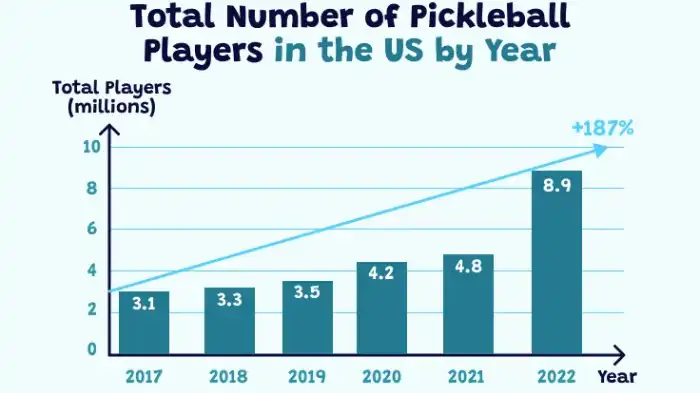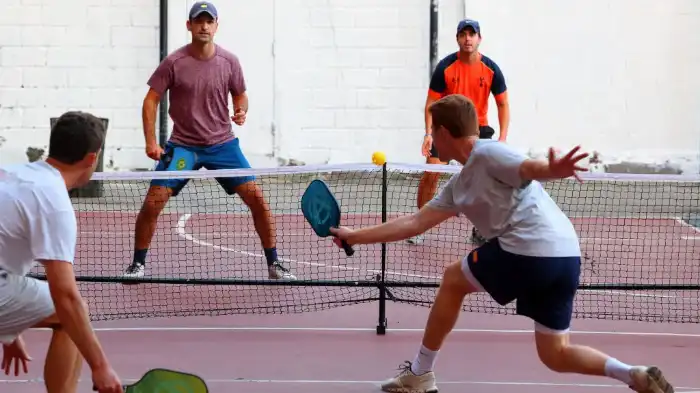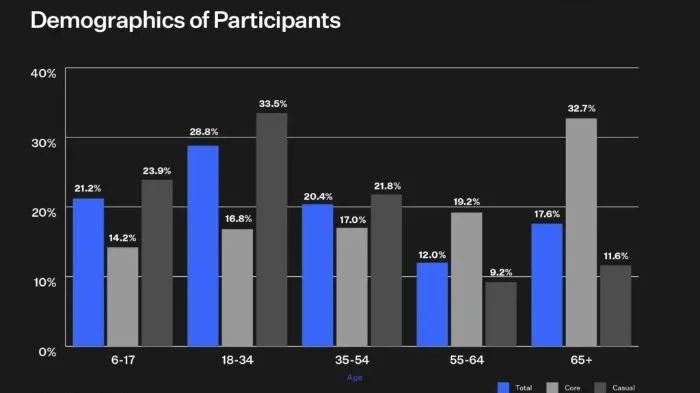Pickleball statistics tell a fascinating tale of a sport on the rise. The world of pickleball is buzzing with impressive numbers and trends that are reshaping the sports landscape. In this blog, we are going to discuss the surprising pickleball statistics that have led to its popularity. After that, we are going to explain why there is a surge in the popularity of this sport.
Surprising Pickleball Statistics That Led to Its Popularity
Popularity Statistics:
- As of early 2022, there are 8.9 million pickleball players in the United States.

- The number of pickleball players increased by 85.7% in 2022.
- The growth rate of the number of pickleball players for the three-year period (2020-22) is 158.6%.
- Out of every three players, two are considered core players, which means that they enjoy pickleball more than eight times a year.
Demographics:
- In 2021, the average age of pickleball players is 38.1 years, which is a decrease from the average age of 41 years in 2020.
- The average age of core players is 47.5 years, while casual players are, on average, 33.6 years old.
- 33% of the core players are over 65 years of age.
- 27.8% of players are in the age bracket 18-34, which is the highest among all the age groups.
Additional Facts:
- Market Value: The global pickleball market exceeded $1.3 billion in 2022 and is expected to surpass $2.3 billion by 2028.
- Player Participation: In 2022, around 14% of adults in the United States gave pickleball a try, and approximately 8.5 million individuals engaged in the sport eight times or more. Among the 36.5 million pickleball players in 2022, 45% have indicated their desire to increase their playing frequency over the upcoming six months.

- Membership Growth: USA Pickleball’s player base, which reached 70,000 members in February 2023, experienced a remarkable 30% increase during 2022.
- Prize Money: The Carvana PPA Tour is offering $5.5 million in prize money across its 25 events in 2023, an 83% increase from 2022. Additionally, Major League Pickleball plans to distribute $5 million in prize money during its six events in 2023.
- Player Earnings: In 2022, professional pickleball players earned an average of about $96,000, with top players making over $200,000. The PPA anticipates a potential 63.9% increase in players’ earnings for 2023.
- Celebrity Endorsement: The sport has attracted high-profile attention with star athletes like LeBron James and Tom Brady investing in professional pickleball teams.
- Sponsorship Boom: The sport is also attracting a new wave of sponsors. Familiar names like Holland America, Anheuser-Busch, Skechers, and Carvana have all signed recent pickleball deals.
These statistics clearly show that pickleball’s popularity is on the rise, making it one of the fastest-growing sports in the US.
Why Pickleball’s Popularity Is Surging?
The surge in pickleball’s popularity can be attributed to several key factors:
Accessibility: Pickleball is easy to learn, and the rules are simple. It doesn’t require a high level of physical fitness or athletic ability, making it accessible to people of all ages and skill levels.
Social Engagement: Pickleball is inherently social. Whether you’re playing with friends, family, or new acquaintances, it promotes interaction and teamwork, fostering strong social bonds within the community.

Health Benefits: The game provides a great cardiovascular workout. Its fast-paced nature keeps players active and helps maintain physical fitness, attracting individuals looking for a fun way to stay in shape.
Aging Population: The sport’s low-impact nature is ideal for seniors. Many older adults turn to pickleball as a means to maintain their physical health and social connections.
Inclusion in Physical Education Programs: The inclusion of pickleball in school physical education programs has introduced younger generations to the sport, ensuring its continued growth.
Cultural Shift: There has been a cultural shift towards health and fitness. People are increasingly seeking sports and activities that offer physical activity, leisure, and a sense of community, all of which pickleball provides.
These factors, combined with its low cost and the sense of community that pickleball fosters, have contributed to the sport’s rapid rise in popularity.
The Future of Pickleball
As we look ahead, it is evident that pickleball’s popularity shows no signs of waning. The sport’s inclusivity, accessibility, and positive impact on individuals and communities continue to drive its growth. We can anticipate a more substantial presence of pickleball in schools, community centers, and public parks in the near future.
Pickleball’s success also prompts the development of better facilities and specialized equipment. As the sport matures, we can expect to see innovations in gear, court design, and rules. This evolution will further enhance the pickleball experience for both recreational and competitive players.
Frequently Asked Questions
The average age of pickleball players is around 38.1 years, with core players averaging 47.5 years and casual players around 33.6 years. The sport attracts a wide age range, with 33% of core players being over 65 and 27.8% falling in the 18-34 age bracket.
Pickleball promotes social engagement, fostering strong bonds within communities. Whether playing with friends, family, or new acquaintances, the sport encourages interaction and teamwork, contributing to a sense of belonging and community.
Yes, pickleball’s inclusion in school physical education programs has introduced the sport to younger generations. This ensures the sport’s continued growth and popularity among youth.
Sponsors are recognizing the growing potential and audience of pickleball. Brands like Holland America, Anheuser-Busch, Skechers, and Carvana have signed deals with the sport to leverage its increasing popularity and engage with its enthusiastic community.
Conclusion
In conclusion, the world of pickleball is experiencing a remarkable surge in popularity, as highlighted by the captivating pickleball statistics. The sport’s rapid growth in the number of players, its diverse player base, and its substantial market value reflect its increasing influence in the sports landscape. As pickleball continues to make its mark, the future looks bright, with the sport’s accessibility, social engagement, and health benefits drawing in players of all ages.
The statistics demonstrate that pickleball is more than just a game; it is a social phenomenon that brings people together, promotes physical fitness, and creates a sense of community. With continued expansion into schools and community spaces, pickleball is poised to further reshape the sports landscape and continue its upward trajectory, making these pickleball statistics even more remarkable.

